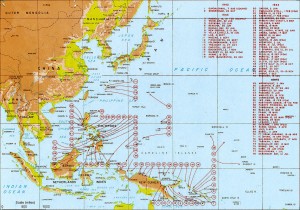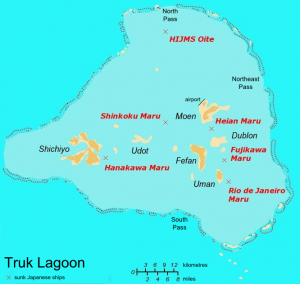Towards the end of 1943, as the US Pacific fleet grew stronger and stronger, the effort to push the Japanese westward back across the Pacific gained momentum.
In early August of 1942, the Americans launched an amphibious landing on Guadalcanal in the Solomon Islands. After months of fighting with dozens of ships sunk in the area, the Japanese withdraw their remaining troops from Guadalcanal in February of 1943.
In June of 1943, the Americans land in New Georgia, also in the Solomons. Shortly after this, in early August, JFK in PT-109 is rammed and sunk. Luckily he survived by swimming to a nearby atoll.
On November 1, 1943, Bougainville, also in the Solomons was invaded. This was followed by landings on New Britain on December 15 and Cape Gloucester on December 26.
At the same time, the first invasion of the Gilbert Islands occured on November 20 at Makin and Tarawa. Although all the landings result in ever increasing numbers of casualties, Tarawa is particularly bad with only 1 Japanese officer and 16 enlisted men surviving out of a garrison of 3600. Of the 12,000 US Marines who landed, more than 3000 are casualties. The US has not seen losses like this since Gettysburg.
On January 31, 1944, Kwajalein in the Marshall Islands is invaded. Casualties are much lighter on Kwajalein which sets up further landings on Ebeye Island on February 3, Engebi on February 18, Eniwetok on February 19 and Parry Island on February 22.
In the midst of these landings, in the Marshalls, the Japanese fleet, anchored in Truk lagoon in the Caroline Islands, is attacked from the air on February 17. At the time, Truk was the Japanese equivalent to Pearl Harbor. It was Japan’s largest naval base outside Japan with aircraft carriers, battleships, and every other type of ship imaginable using the base. Having some idea that the US was about to attack, the Japanese withdrew their large ships including all the carriers and battleships and heavy cruisers. The US attack with carrier based aircraft sank 12 warships and 32 merchant ships making Truk lagoon the largest ship graveyard in the world. There were more than 40,000 Japanese servicemen on Truk. Thousands died during the attack. Some would only surrender in October of 1945.
Truk was attacked by a task force that included five aircraft carriers including Enterprise, Yorktown, Essex, Intrepid and Bunker Hill. Dozens of other ships also took part. From airfields all over the atoll, the Japanese launched aircraft to try to fight off the attack. But the overwhelming superiority of the new Grumman F6F Hellcat fighters was no match for the pre-war designed Zero. Additionally, the US had vastly superior pilots by this time as most of the best trained Japanese pilots were already lost. Hundreds of Japanese planes were shot down or destroyed on the ground. Thousands of Japanese were killed either on the ships or on the ground. US loses were relatively light, only 25 planes and 40 men.
Today a number of these wrecks are reachable by divers with amazing opportunities to view airplanes, tanks and all manner of military equipment.
When diving in Truk, keep in mind of the terrible price paid by those who fought all the way from Pearl Harbor to get there. And be respectful that many thousands of Japanese also perished defending the atoll.


